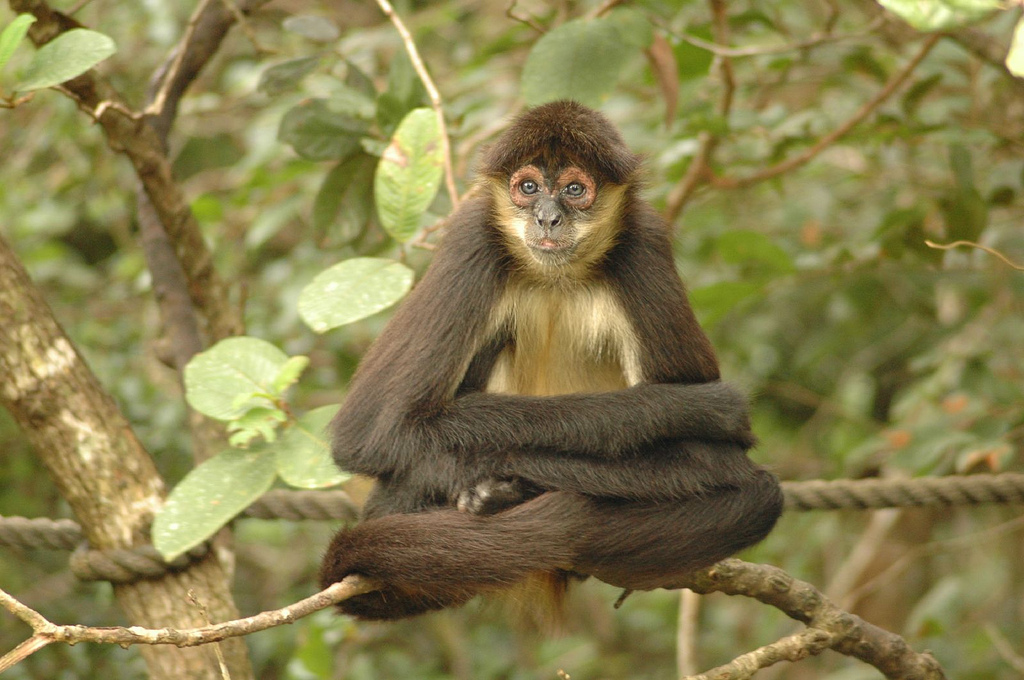The spider monkey (genus Ateles) is amongst the most captivating primates of the New World. Renowned for their agility and social dynamics, these monkeys play a crucial role in the biodiversity and health of tropical rainforests. This article will explore the characteristics, habitat, diet, and social behavior of spider monkeys, delve into the threats they face, and underscore the importance of primate conservation in the rainforest.
Characteristics of the Spider Monkey
Spider monkeys are distinguished by their slender bodies and long, flexible limbs, which, along with their prehensile tails, inspire their common name. Their tails, which can reach lengths of up to 89 centimeters, are particularly noteworthy for their dexterity and strength, often serving as a “fifth hand” to swing between branches or pick up objects.
Spider monkeys have a body length of 38 to 59 centimeters and can weigh between 6 and 9 kilograms, with females generally being smaller than males. Their fur color varies from golden to dark brown or black, depending on the species. They possess a distinctive lack of thumbs, thought to be an adaptation that makes brachiation – the primary form of locomotion – more efficient.

Habitat and Social Behavior
Spider monkeys inhabit a range of tropical rainforest environments, from wet and evergreen forests to mangroves and mountain forests, spread across Central and South America. They are diurnal, arboreal creatures, spending the majority of their lives high in the forest canopy.
Spider monkeys are highly social animals, living in large groups of 20 to 40 individuals, although they typically split into smaller subgroups to forage during the day. They have a fission-fusion social system, similar to that of chimpanzees, characterized by flexible grouping patterns in response to food availability and other environmental factors.
Communication in spider monkey groups is rich, involving a range of vocalizations, facial expressions, and body postures. They have been observed to maintain strong social bonds, often through grooming and play behavior.
The Diet and Role of Spider Monkeys in the Ecosystem
Spider monkeys are primarily frugivorous, with fruits making up to 90% of their diet. However, they also consume leaves, flowers, bark, honey, insects, and even bird eggs. They play a vital role in the rainforest ecosystem as seed dispersers. By consuming a wide variety of fruits, they contribute to forest regeneration and biodiversity by dispersing the seeds through their feces across large distances.
Threats to the Spider Monkey
Unfortunately, spider monkeys face significant threats, primarily due to human activities. Deforestation, driven by logging, agriculture, and urban development, is destroying and fragmenting their habitats. This habitat loss not only reduces the availability of food and shelter but also isolates populations, leading to inbreeding and reduced genetic diversity.
Hunting poses another major threat. Spider monkeys are hunted for bushmeat, and infants are often captured for the illegal pet trade after their mothers are killed.
Disease transmission from humans and domestic animals can also impact spider monkey populations. Climate change further exacerbates these threats, leading to shifts in food availability and potentially increasing the frequency and intensity of extreme weather events that can impact their habitats.
How is the Spider Monkey being conserved?
Spider monkeys are considered “umbrella species” – protecting them and their habitats can benefit a wide range of other species that share the same environment. Additionally, as primates, they serve as significant indicators of ecosystem health due to their sensitivity to environmental change.
Conservation efforts for spider monkeys and other primates require multi-faceted, integrated approaches. Establishing and properly managing protected areas, such as national parks and reserves, is a critical first step. However, these areas must be large and connected enough to support viable primate populations.
Community-based conservation efforts can also be highly effective, often providing local economic incentives for conservation through ecotourism or sustainable agriculture. Education and awareness campaigns are also essential to change local perceptions and behaviors towards primates and their habitats.
Law enforcement is another crucial aspect of primate conservation. Strengthening the enforcement of laws against hunting and illegal pet trade can significantly reduce threats to spider monkeys and other primates. International cooperation is also needed to regulate and reduce the trade of primates and primate products.
Research and monitoring are vital to inform and guide these conservation efforts. This includes studying the behavior, ecology, and population trends of spider monkeys, identifying key threats, and monitoring the effectiveness of conservation interventions.
Conclusion
The spider monkey, with its distinctive characteristics, captivating social dynamics, and vital ecological role, is a remarkable symbol of the rich biodiversity of tropical rainforests. However, like many other primates, it faces substantial threats due to human activities.
The conservation of spider monkeys and other primates is not just about saving individual species. It is about preserving the intricate web of life that characterizes our planet’s rainforests. These ecosystems, apart from hosting a vast array of life, also provide crucial services to humanity, from carbon sequestration and climate regulation to sources of food, medicine, and cultural inspiration.
In a world facing unprecedented environmental challenges, the conservation of spider monkeys and their rainforest homes is both an ecological necessity and a moral imperative. It is a challenge that requires science, collaboration, and compassion, and one that we must rise to meet for the sake of all life on Earth.
Help us Help Them! Think Wildlife Foundation is a non profit organization with various conservation initiatives. Our most prominent campaign is our Caring for Pari intiative. Pari is a rehabilitated elephant at the Wildlife SoS Hospital. 25% of the profits from our store are donated to the elephant hospital for Pari. Other than buying our wonderful merchandise, you could donate directly to our Caring For Pari fundraiser.
Written by: Sanghmitra Singh
